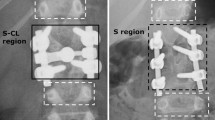Abstract
Purpose
The aim of this retrospective study was to evaluate the changes in the vertebral body and spinal canal area in a group of patients who had pedicle screw fixation under age 5 for the treatment of congenital spinal deformity at least 5 year follow-up.
Methods
11 patients who had been operated due to spinal deformity under age 5 with who had a CT examination at least 5 years after the initial operation were included in the study. All patients underwent hemivertebrectomy and transpedicular fixation procedures at an average age of 3.18 years (range 2–5 years). All had preoperative CT to evaluate the congenital deformities. Measurements were done at the instrumented vertebrae as well as the un-instrumented ones above and below them to evaluate; vertebral body parameters, pedicle parameters and spinal canal area of upper instrumented vertebra (UIV), lower instrumented vertebra (LIV), upper adjacent un-instrumented vertebra and lower adjacent un-instrumented vertebra.
Results
The average follow-up was 7.2 (range 5–12) years. Six of the patients were over age 10 during the final CT examination while 5 were at age 7. Female-to male ratio was 8–3. Measurement of all the parameters in 22 instrumented and 22 non-instrumented segments showed a proportional increase rather than a decrease at each segment. The percentage of canal area growth at UIV and LIV was 21 and 17.5 %, respectively.
Conclusion
Pedicle screw instrumentation has no adverse effect on further spinal body, pedicle and canal growth and does not result in iatrogenic spinal canal stenosis.




Similar content being viewed by others
References
Xue X, Shen J, Zhang J, Li S, Wang Y, Qiu G (2014) X-Ray assessment of the effect of pedicle screw on vertebra and spinal canal growth in children before the age of 7 years. Eur Spine J 23(3):520–529
Ruf M, Harms J (2002) Pedicles crews in 1- and 2-year-old children: technique, complications, and effect on further growth. Spine 27(21):E460–E466 (PhilaPa 1976)
Olgun ZD, Demirkiran G, Ayvaz M, Karadeniz E, Yazici M (2012) The effect of pedicle screw insertion at a young age on pedicle and canal development. Spine 37(20):1778–1784 (PhilaPa 1976)
Zhou X, Zhang H, Sucato DJ, Johnston CE (2014) Effect of dual screws across the vertebral neurocentral synchondrosis on spinal canal development in an immature spine: a porcine model. J Bone Joint Surg Am 96(17):e146
Porter RW, Pavitt D (1987) The vertebral canal: I. Nutrition and development, an archaeological study. Spine 12:901–906
Vital JM, Beguiristain JL, Algara C et al (1989) The neurocentral vertebral cartilage anatomy, physiology and physiopathology. Surg Radiol Anat 11:323–328
Zhang H, Sucato DJ, Nurenberg P et al (2010) Morphometric analysis of neurocentral synchondrosis using magnetic resonance imaging in the normal skeletally immature spine. Spine 35:76–82 (PhilaPa 1976)
Cil A, Yazici M, Daglioglu K et al (2005) The effect of pedicle screw placement with or without application of compression across the neurocentralcartilage on the morphology of the spinal canal and pedicle in immature pigs. Spine 30(11):1287–1293 (PhilaPa 1976)
Wang L, Luo ZJ, Luo LJ, Feng LJ, Meng H (2009) The effect of pedicle screw insertion through the neurocentralcartilage on the growth of immature canine vertebra. Orthop Surg 1(2):137–143
Fekete TF, Kleinstück FS, Mannion AF, Kendik ZS, Jeszenszky DJ (2011) Prospective study of the effect of pedicle screw placement on development of the immature vertebra in an in vivo porcine model. Eur Spine J 20(11):1892–1898
Dimeglio A (2001) Growth in pediatric orthopaedics. J Pediatr Orthop 21(4):549–555
Rajwani T, Bhargava R, Lambert R et al (2002) Development of the neurocentral junction as seen on magnetic resonance images. Stud Health Technol Inform 91:229–234
Zhang H, Sucato DJ (2011) Neurocentralsynchondrosis screws to create and correct experimental deformity: a pilot study. Clin Orthop Relat Res 469(5):1383–1390
Farber GL, Place HM, Mazur RA, Jones DE, Damiano TR (1995) Accuracy of pedicle screw placement in lumbar fusions by plain radiographs and computed tomography. Spine 20(13):1494–1499 (Phila Pa 1976)
Pace N, Ricci L, Negrini S (2013) A comparison approach to explain risks related to X-ray imaging for scoliosis, 2012 SOSORT award winner. Scoliosis 8(1):11
Author information
Authors and Affiliations
Corresponding author
Ethics declarations
Conflict of interest
None.
Additional information
This study was performed at Istanbul Spine Center, Florence Nightingale Hospital, Istanbul, Turkey.
Rights and permissions
About this article
Cite this article
Kahraman, S., Karadereler, S., Cobanoglu, M. et al. Does pedicle screw fixation under age 5 cause spinal canal narrowing? A CT study with minimum 5 years follow-up. Eur Spine J 25, 1665–1673 (2016). https://doi.org/10.1007/s00586-016-4484-6
Received:
Revised:
Accepted:
Published:
Issue Date:
DOI: https://doi.org/10.1007/s00586-016-4484-6




